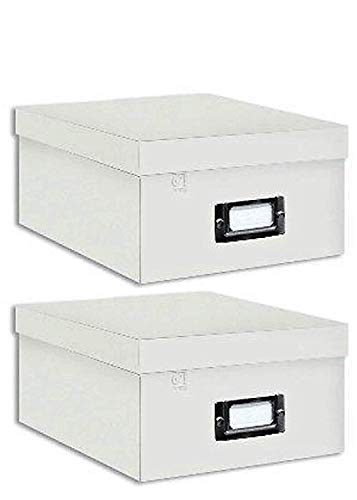Archival photo storage boxes are designed to safely store and protect photographs, negatives, slides, and other photographic materials over an extended period of time. Their purpose is to prevent damage caused by external factors such as light, moisture, dust, and physical handling, which can lead to fading, discoloration, degradation, and deterioration of the images.
- 1. Fuctions and features of archival photo storage boxes
- 1.1. Protection from light
- 1.2. Acid-free materials
- 1.3. Lignin-free materials
- 1.4. pH neutrality
- 1.5. Size and design
- 1.6. Dust and moisture resistance
- 1.7. Stackability and durability
- 2. Material of archival Photo storage boxes
- 2.1. Acid-free cardboard
- 2.2. Archival-grade paper
- 2.3. Buffered paper
- 2.4. Polyester (Mylar)
- 2.5. Polypropylene
- 3. Why should buy archival photo storage boxes?
- 3.1. Preservation
- 3.2. Prevents fading and discoloration
- 3.3. Organization
- 3.4. Safe handling
- 3.5. Convenience
- 3.6. Historical and sentimental value
- 3.7. Long-term cost savings
- 4. How to choose archival photo storage boxes?
- 4.1. Material
- 4.2. Size
- 4.3. Design and Construction
- 4.4. Archival-Safe Features
- 4.5. Compatibility with Inserts
- 4.6. Labeling and Organization
- 4.7. Stackability
- 4.8. Price and Brand
- 5. In conclusion
Fuctions and features of archival photo storage boxes
Here are some key functions and features of archival photo storage boxes:
Protection from light
Archival photo storage boxes are typically made from acid-free and lignin-free materials that block out harmful UV light. This helps to prevent fading and color shifting of the photographs.
Acid-free materials
Acid-free boxes are crucial for preserving photographs because acidic materials can cause the images to deteriorate over time. Archival boxes are made from acid-free cardboard or specialty archival materials that do not release harmful acids.
Lignin-free materials
Lignin is a natural component of wood pulp, and when it breaks down, it can release acids that damage photographs. Archival boxes are often lignin-free or made from lignin-free paper to minimize the risk of acid migration.
pH neutrality
Archival photo storage boxes are pH-neutral or slightly alkaline to ensure that they do not promote chemical reactions that could harm the photographs. This helps maintain the stability and longevity of the images.
Size and design
Archival photo storage boxes come in various sizes and designs to accommodate different photograph formats, including standard sizes like 4x6, 5x7, and 8x10 inches. Some boxes feature dividers or compartments to separate and organize the photos.
Dust and moisture resistance
Archival boxes are often designed with tight-fitting lids or closures to keep out dust and minimize exposure to moisture. This helps protect the photographs from physical damage and mold or mildew growth.
Stackability and durability
Archival photo storage boxes are typically sturdy and stackable, allowing for efficient storage and organization of large collections. They are designed to withstand frequent handling and protect the photographs from accidental bending or tearing.
By using archival photo storage boxes, individuals and institutions can ensure the long-term preservation of their valuable photographic materials, allowing future generations to enjoy and study these visual records of history, events, and personal memories.

Material of archival Photo storage boxes
Archival photo storage boxes are typically made from materials that are specifically chosen for their preservation qualities. The materials used in archival photo storage boxes are selected to be acid-free, lignin-free, and pH-neutral or slightly alkaline. Here are some common materials used in the production of archival boxes:
Acid-free cardboard
Archival photo storage boxes often utilize acid-free cardboard or archival-grade paperboard. This type of cardboard is manufactured without acidic components that could potentially harm photographs.
Archival-grade paper
Some archival boxes are constructed using specialty archival-grade paper that is acid-free, lignin-free, and pH-neutral. This paper is designed to be long-lasting and non-reactive, minimizing the risk of deterioration.
Buffered paper
Buffered paper is another material commonly used in archival boxes. It contains an alkaline substance, such as calcium carbonate, which helps neutralize any acidic compounds that may be present. Buffered paper is particularly useful for mitigating acid migration from external sources.
Polyester (Mylar)
Polyester, often referred to by the brand name Mylar, is a transparent, archival-quality material used for sleeves or enclosures within archival photo storage boxes. Polyester is highly stable, chemically inert, and resistant to tearing, making it an excellent choice for protecting photographs from physical damage.
Polypropylene
Polypropylene is another synthetic material used in archival photo storage. It is acid-free, non-reactive, and offers good moisture resistance. Polypropylene sleeves or envelopes are commonly used to store and protect photographs within the boxes.
It's important to note that the specific materials used can vary among different manufacturers and brands. However, the key characteristic is that archival photo storage boxes are made from materials that are free from acidic compounds, lignin, and other harmful elements that could accelerate the deterioration of photographs over time.
Why should buy archival photo storage boxes?
There are several reasons why you should consider buying archival photo storage boxes:
Preservation
Archival photo storage boxes are specifically designed to protect your photographs from deterioration and damage. They provide a controlled environment that minimizes exposure to light, moisture, dust, and other harmful elements, thus extending the lifespan of your photos.
Prevents fading and discoloration
Archival boxes are made from acid-free and lignin-free materials that block out UV light, which is a significant cause of fading and color shifting in photographs. By storing your photos in these boxes, you can help preserve their original colors and clarity for a longer time.
Organization
Archival photo storage boxes come in various sizes and designs, allowing you to organize your photos systematically. They often feature dividers or compartments, making it easier to categorize and locate specific images within your collection.
Safe handling
Archival boxes provide a protective barrier that reduces the risk of physical damage to your photographs. They are sturdy and designed to withstand frequent handling, ensuring that your photos remain intact and unharmed.
Convenience
Having all your photos stored in archival boxes makes it convenient to access and share them whenever needed. You can easily locate specific photos without the risk of damage or misplacement that may occur with improper storage.
Historical and sentimental value
Photographs capture important moments, memories, and milestones in our lives. By investing in archival photo storage boxes, you are safeguarding these irreplaceable treasures for future generations to enjoy and learn from. Preserving family histories, documenting cultural events, or preserving historical records becomes easier when stored properly.
Long-term cost savings
Investing in archival photo storage boxes may seem like an additional expense initially, but it can save you money in the long run. Proper storage helps prevent the need for costly photo restoration or reproduction services due to damage caused by improper storage methods.
Overall, archival photo storage boxes provide a reliable and protective solution for preserving your photographs. By ensuring their safety and longevity, you can cherish and pass down these visual memories for years to come.
How to choose archival photo storage boxes?
Choosing archival photo storage boxes is an important step in preserving and protecting your precious photographs. Here are some factors to consider when selecting the right storage boxes:
Material
Look for storage boxes made from archival-quality materials. Acid-free and lignin-free boxes are recommended as they won't contribute to the deterioration of your photos over time. Archival-quality boxes are usually made from acid-free paperboard or acid-free plastic.
Size
Consider the size of your photo collection and choose storage boxes that can accommodate your needs. Look for boxes that come in various sizes to accommodate different photo dimensions. It's also a good idea to choose boxes that can hold a sufficient number of photos without overcrowding them.
Design and Construction
Look for storage boxes that are sturdy and well-constructed. They should have reinforced corners and edges to protect your photos from damage. Additionally, consider whether you prefer a box with a removable lid or a hinged lid for easier access.
Archival-Safe Features
Some storage boxes may come with additional archival-safe features, such as UV protection to shield your photos from light damage. These features can help to further safeguard your photographs
Compatibility with Inserts
If you plan to use archival sleeves or envelopes to store your photos within the boxes, ensure that the boxes you choose are compatible with the inserts you intend to use. This will allow you to organize and protect your photos more effectively
Labeling and Organization
Look for storage boxes that have labeling areas or come with label holders. This will help you keep your photos organized and easily locate specific images when needed.
Stackability
If you have a large collection of photos, consider whether the storage boxes are designed to be stackable. This feature can help save space and make it easier to store and access your photos.
Price and Brand
Compare prices and read reviews to find storage boxes that offer good value for money. Trusted archival brands often provide reliable products, but it's always a good idea to do some research before making a purchase.
Remember, proper storage conditions are crucial for preserving your photographs. In addition to using archival storage boxes, make sure to store them in a cool, dry, and well-ventilated area, away from direct sunlight, high humidity, and extreme temperatures.
In conclusion
Archival Photo Storage Boxes is a useful product which help protecting your photographs. With our above give, we hope that it can help you to choose a suitable archival photo storage boxes. There are many available archival photo storage boxes in market.To make you easily choose suitable product, we reviewed and selected top best photo storage boxes in our website. That evaluation bases on experience of users and experts. To have more products, you also check out Amazon. Amazon offers you various product with wide price range. We are sure that you will find the product fit with your budget.











